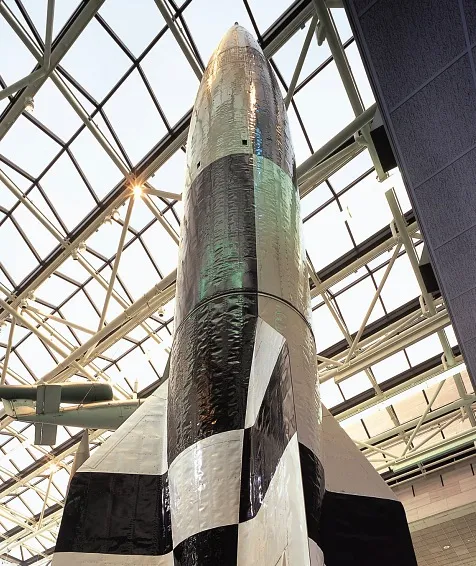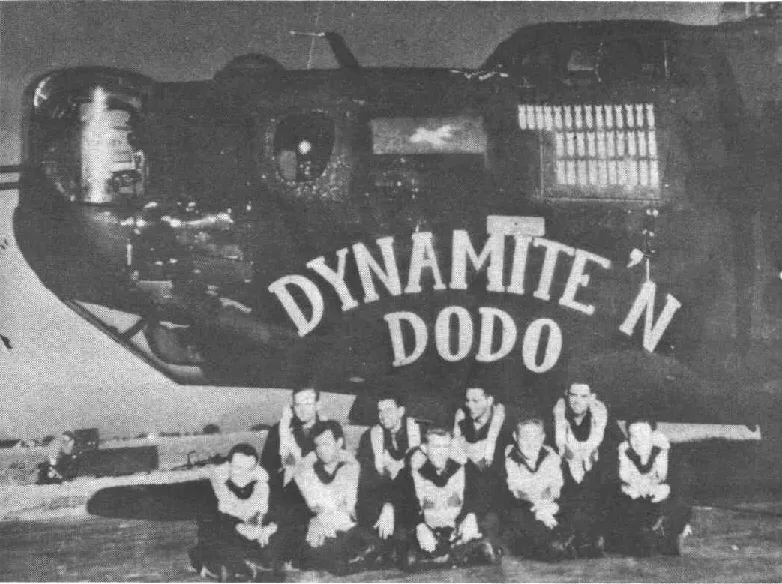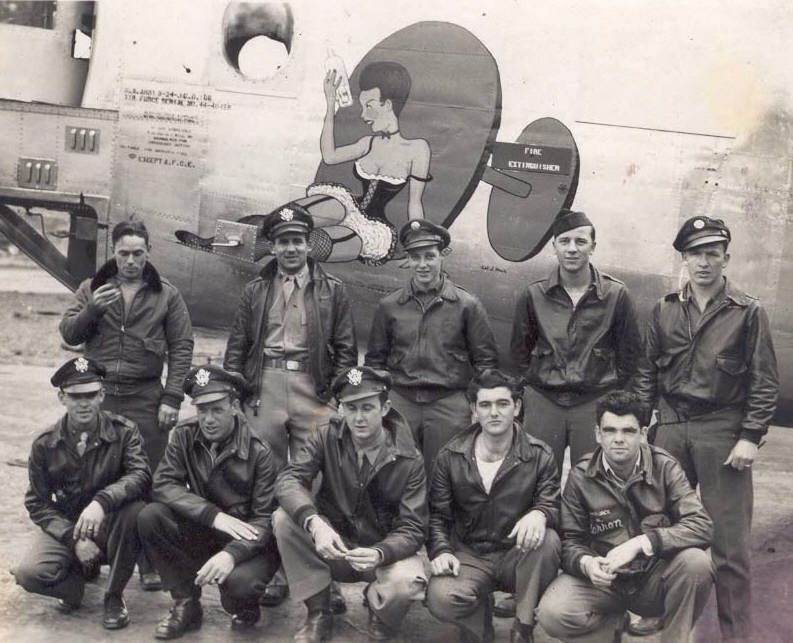Did a B-24 Really Shoot Down a V-2 Rocket in 1944?
On the trail of a tall tale.
:focal(465x379:466x380)/https://tf-cmsv2-smithsonianmag-media.s3.amazonaws.com/filer/04/cb/04cb51c2-7589-42d3-85d1-460255a6e646/b-17_v-2.jpg)
The story has made the rounds in books and on websites, on Wikipedia and in U.S. Missile Defense Agency reports: the only V-2 ever shot down in flight was destroyed by a B-24 bomber. Shame that it almost certainly didn’t happen.
The V-2 was one of the most impressive technologies to emerge from WWII. A liquid-fueled, gyroscope-guided rocket, it was the first human-built object to reach outer space. In 1944 it was a fearsome weapon, and thanks to its speed and ballistic launch trajectory, it was essentially unkillable. Fighter aircraft were nowhere near fast enough to hit the missile, though at least one serious attempt was made by an enthusiastic Royal Air Force pilot as it took off (he missed).
Different publications cite different sources for the story of the B-24 that shot down a V-2, but all can ultimately be traced to David Johnson’s book V1-V2: Hitler’s Vengeance on London, published in 1982. Late in the book the following passage appears:
A squadron of four-engine B-24 Liberators of the US 34th Bomb Group was returning to England, flying over the Low Countries at about 10,000 feet, when a V-2 passed right through their formation. To an engineer-gunner aboard one of the bombers, the rocket looked like ‘a telephone pole with fire squirting out of its tail’.
Right after he spotted it, the gunner heard a machine gun open fire at the missile—“a left waist gunner in our squadron let fly a burst and down it went”.…After the B-24 got back to base, its crew chief painted a V-2 on the side of the plane.
If that sounds impressive, it is. V-2s were blindingly fast off the launch pad; at 10,000 feet a V-2 would probably have been supersonic, difficult enough to track, and all but impossible to hit. Still, maybe the B-24 gunner looked in just the right place at just the right time to notice the launching rocket, and just happened to have his .50 caliber guns pointed near its flight path. With the right timing and a whole lot of luck, might the scenario be plausible?
The world’s foremost aviation historians work down the street at the National Air and Space Museum (which has a V-2 on display), so I went to them for guidance.

The story was new to V-2 historians Michael Neufeld and retired colleague Frank Winter, both of whom reacted with skepticism. Shooting down a V-2 was not a realistic possibility at the time, they said. The only serious attempt was by British anti-aircraft guns, which tried putting as many bullets as possible into a V-2’s projected path, a dubious enough system that was quickly abandoned. An electronic countermeasure to jam the missile’s radio guidance frequency was also abandoned after someone noticed that V-2s were not guided by radio waves (they had sophisticated internal gyroscopes). Winter wrote in an email that Johnson’s is “a popular book that can’t be trusted as a scholarly source.”
The claim in Johnson’s book is unattributed, but his only listed interviewee from the 34th Bomb Group is one Jack Blackham, a B-24 gunner who died in 2000.
John Funk runs a website about the 34th BG that includes archived editions of Mendlesham Memories, the Group newsletter named after the airfield from which it flew. I asked for Funk’s help, but he could find no reference to any V-2 encounters. Blackham’s name, however, came up several times in reference to a reported V-1 Buzz Bomb shootdown. In 1986, Blackham wrote in with a question:
In late July or early August, 1944, returning from a mission we passed over Holland just as the Germans launched a V-1 Buzz Bomb. It flew close to our 4th Sqdn formation and a left waist gunner from one of the planes shot it down. I would like to find out who that gunner was. I remember the plane because it had a buzz bomb painted on the side near the bomb scores under the pilot’s window. If anyone remembers who it was please let me know.
Though still very high-tech for the time, the V-1 had nowhere near the capability of the V-2. It flew at low altitudes and speeds, even by the standards of WWII aircraft. Ground-based anti-aircraft weapons regularly shot them down as they motored overhead, and British fighters occasionally took them down with the unusual method of nudging them off course using their wings. A heavy bomber downing a V-1 in flight is a much more believable scenario than shooting down a V-2, and it would still be tremendous news—not to mention the only known occurrence of its kind.
In fact, someone answered Blackham’s question: Hawley Hudson, a gunner on Noble Wright’s crew (crews were recorded by their lead pilot’s name) reported to the editor that their top turret gunner, George Baldwin, shot the V-1 down. But he gave no additional detail, including how he knew.
The newsletter contains two pictures of a B-24 named Dynamite ‘n ‘Dodo, with a V-1 kill marking on its nose, one with the Wright crew—including George Baldwin—in front of it. That established a date range: the first V-1 was launched against Britain on June 13, 1944, and Dynamite ‘n Dodo was transferred to another group (and renamed Percolatin’ Pete) in late August 1944, when the 34th converted to B-17s. Wright’s crew flew the aircraft on most of its missions until the transfer.

But this is where things get confused.
Pilot Al Swenson also wrote to Mendlesham Memories claiming that his crew shot down the V-1:
One day I’ll have to write the story of how Jack Barron was able to shoot down the first (I think the only one by a bomber) Buzz-Bomb. The English flak gunners who covered the ground beneath us were tracking our progress because the buzz bomb was coming along behind us. Jack fired when it was directly overhead, upsetting the gyro and we watched it crash into a hill. His kill was confirmed by the flak gunners, and the following morning our ground crew chief had already stenciled a buzz bomb along with the other strikes.
A picture elsewhere in the newsletter shows a mysterious person leaning on a top turret with the caption “This man, name unknown, shot down the first and only Buzz-Bomb ever downed by a heavy bomber. He was in the 7th sq on Lt. Swenson’s crew.” A picture of Swenson’s crew shows the same man. But Swenson’s top turret gunner was Robert Gillespie, and while Swenson’s pictured crew is unidentified, his position in the newsletter picture suggests that it is Gillespie. Swenson is only recorded flying Dynamite ‘n Dodo on one mission: June 25, 1944. The detailed debriefing notes from that day, posted on the newsletter’s successor website Valor to Victory, are relatively uneventful, and contain no mention of any enemy aircraft, much less a V-1.

That’s quite odd. Downing a V-1 from a bomber would be quite an achievement, and the envy of every flier in Europe. It would surely be noted in documents high and low.
Time to go straight to the source.
The Air Force Historical Research Agency at Maxwell AFB, Alabama, tends the official archive of what was then a branch of the Army. Archivist Thomas Lauria generously volunteered to go through the mission reports and unit diaries of the 34th BG on that day and send me what he could. But he came up with nothing. “For the month of June 1944, EVERY little detail, good news story, ‘war story’, etc. is documented,” he emails. “Every Red Cross dance and each guy that had guard duty is listed; how many bullets and bombs they dropped is documented, but no V-1 shoot down is mentioned.”
Lauria then checked nearby dates—nothing—then every monthly diary the unit had, as well as those of parent units 93rd Bomb Wing, 3rd Air Division and 8th Air Force from June, 1944 to May, 1945 when the war ended: nothing. Then he checked the records of Operation Crossbow, which catalogued all known V-1 kills as part of the operations against them. No record of a bomber is to be found.
The strangest part is another Mendlesham Memories story. Clifford Thompson wrote in:
I was a tail gunner on Jack Schifferer’s crew and I shot down a buzz bomb over the Channel in early 1945. Weather was closed in over England and we headed down individually to form over France. A buzz bomb missed us overhead by about 100ft. I got it in my sights, nailed it, and it exploded. Jack mentioned it on debriefing and, after checking, the Admiralty confirmed time and place.
Schifferer’s crew didn’t fly until early 1945, by which time the 34th was flying B-17s. Thompson’s is an outlier story, with no other accounts to back it up. It may be there was a second incident similar to the first. It may be Thompson was mistaken, or just made it up. We have no way to tell.
Memory is notoriously pliable and open to suggestion. The newsletter accounts were not published until 40 years after the war, plenty of time for stories to change naturally. The matter-of-fact way most of the veterans write about these incidents, with differing details but no doubt about the central fact, is exactly what one would expect of a true story after so much time. The only paper evidence is the picture of Dynamite ‘n Dodo with the kill marking drawn on its nose, which modern historians would consider circumstantial.
So who shot the V-1 down? Was it George Baldwin, with Wright’s crew? Was it Jack Barron or Robert Gillespie on Swenson’s crew? Are they all confused with Clifford Thompson, or is that a separate incident? And why would such big news not be recorded in the meticulous official notes? Did it even happen?
John Funk put me in touch with one of the few remaining men of the 34th BG, a New Mexico pilot named Al Israelsen. Israelsen remembers seeing V-1s from the air and from the ground, but doesn’t remember anyone mentioning shooting one down. He does, however, remember hearing a little about Jack Blackham:
“My information on Sgt Blackham is second-hand. I did not know him but did know very well the two pilots that were his crew commanders for his tour there at Mendlesham,” Israelsen wrote. “I do remember that both Lt. Bice and Lt. Dreher, who flew copilot on my crew No1 (to and from 7/07/44 respectively) remarked that Sgt. Blackham was a problem crewman when they were the crew first pilot and that his stories were exaggerated.”
And there I’ve hit a dead end. Despite the puzzling lack of written evidence, the V-1 shootdown seems like a real possibility. But the V-2 downing is traced to an unreliable book, seemingly based on an interview with an apparently unreliable source. Safe to say it probably did not happen, even though it it is already out there as a fact, and will certainly continue as myth.
I will, however, amend the Wikipedia page.